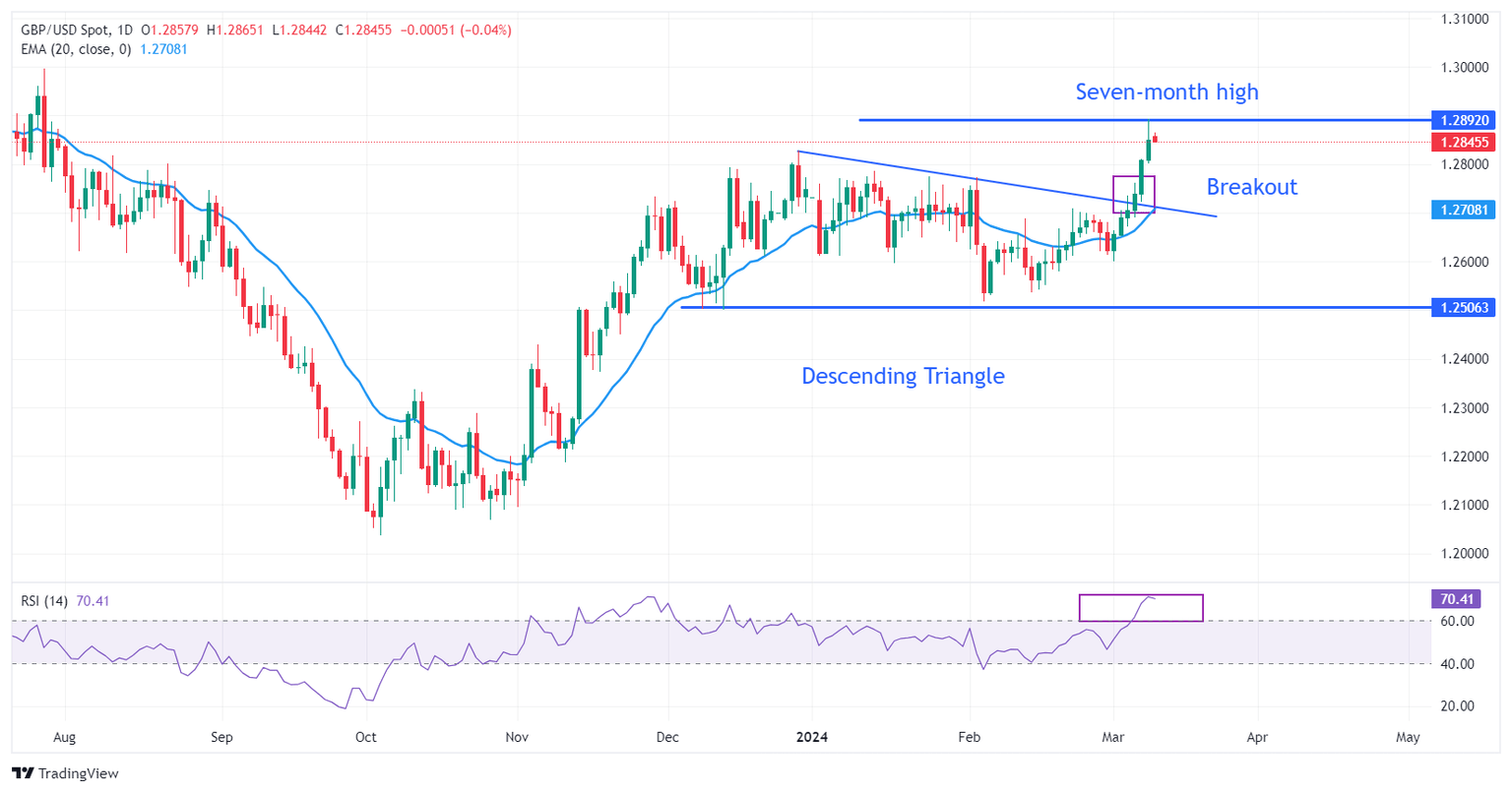Pound Sterling falls amid uncertainty ahead of data-packed week
- The Pound Sterling faces a sell-off ahead of the UK labor market, US CPI data.
- The UK wage growth data will provide fresh cues about the inflation outlook.
- The broader market sentiment remains upbeat as hopes for Fed rate cuts in June remain firm.

The Pound Sterling (GBP) faces selling pressure in Monday’s late European session amid uncertainty ahead of a data-packed week. The GBP/USD pair drops ahead of the United Kingdom Employment and monthly Gross Domestic Product (GDP), which will be published on Tuesday and Wednesday, respectively.
UK labor market data for the three months ending in January will give clues about job growth and wage growth momentum, which has been a major driving factor in stubborn inflationary pressures. Persistent wage growth could push back market expectations for Bank of England (BoE) rate cuts to the August meeting. BoE policymakers said that inflation is expected to come down to the 2% target by summer, but that it could flare up again afterwards.
Outside the UK, the Pound Sterling will be impacted by the market sentiment, which will be guided by the United States Consumer Price Index (CPI) data for February, to be released on Tuesday. Hot inflation data could dent firm expectations for the Federal Reserve (Fed) reducing interest rates in June. Prospects for a Fed rate cut in June remain firm as the US Nonfarm Payrolls (NFP) report for February indicated that labor market conditions are cooling. The data showed that, while hiring by US employers remained strong, the Unemployment Rate rose and wage growth softened.
Daily digest market movers: Pound Sterling weakens ahead of busy UK economic calendar
- The Pound Sterling struggles to hold strength against the US Dollar as the market mood turns cautious ahead of the United States inflation data for February.
- However, the broader market sentiment is still upbeat as expectations for the Federal Reserve rate cut in the June policy meeting persist after the release of the US Employment report on Friday, which showed softening wage growth and a higher Unemployment Rate. The CME Fedwatch tool shows a 57% chance that a rate-cut decision of 25 basis points (bps) will be announced in June.
- On the domestic front, investors await fresh guidance on the Bank of England interest rates. The BoE is expected to reduce interest rates in the August meeting after tightening its policy stance for over two years. However, the wage growth data for the three months ending in January, to be released on Tuesday, could influence market expectations for rate cuts.
- Investors anticipate that wage growth, excluding bonuses, was steady at 6.2%. In the same period, Average Earnings, including bonuses, are forecast to have grown at a slightly slower pace of 5.7% against the former reading of 5.8%. Sticky wage growth would dampen hopes of early rate cuts by the BoE.
- BoE policymakers have been warning that wage growth remains a major barrier to progress in consumer price inflation declining towards the 2% target. Wage growth remains almost double what is required to be consistent for inflation to return to target. Strong wage growth momentum has been feeding inflation, particularly in the services sector, where prices accelerated in the November-January period.
- Apart from the labor cost growth data, investors will also focus on the broader labor market data, as the BoE needs to achieve full employment and price stability to achieve the dual mandate. The Unemployment Rate for the three months ending January is expected to remain unchanged at 3.8%.
Technical Analysis: Pound Sterling fails to extend six-day winning spell
The Pound Sterling weakens against the US Dollar on a cautious market mood. The GBP/USD pair edges down from a seven-month high near the round-level resistance of 1.2900. The pair struggles to extend its six-day winning spell on Monday as investors await fresh guidance on interest rates. The GBP/USD pair posted a strong upside move after breaking out from the Descending Triangle formation on the daily time frame. The near-term appeal is upbeat, and the 20-day Exponential Moving Average (EMA) at 1.2710 should act as a major cushion for the Pound Sterling bulls.
The 14-period Relative Strength Index reaches 70.00, exhibiting momentum towards the upside. No signs of overbought and divergence keep doors open for more upside.
BoE FAQs
The Bank of England (BoE) decides monetary policy for the United Kingdom. Its primary goal is to achieve ‘price stability’, or a steady inflation rate of 2%. Its tool for achieving this is via the adjustment of base lending rates. The BoE sets the rate at which it lends to commercial banks and banks lend to each other, determining the level of interest rates in the economy overall. This also impacts the value of the Pound Sterling (GBP).
When inflation is above the Bank of England’s target it responds by raising interest rates, making it more expensive for people and businesses to access credit. This is positive for the Pound Sterling because higher interest rates make the UK a more attractive place for global investors to park their money. When inflation falls below target, it is a sign economic growth is slowing, and the BoE will consider lowering interest rates to cheapen credit in the hope businesses will borrow to invest in growth-generating projects – a negative for the Pound Sterling.
In extreme situations, the Bank of England can enact a policy called Quantitative Easing (QE). QE is the process by which the BoE substantially increases the flow of credit in a stuck financial system. QE is a last resort policy when lowering interest rates will not achieve the necessary result. The process of QE involves the BoE printing money to buy assets – usually government or AAA-rated corporate bonds – from banks and other financial institutions. QE usually results in a weaker Pound Sterling.
Quantitative tightening (QT) is the reverse of QE, enacted when the economy is strengthening and inflation starts rising. Whilst in QE the Bank of England (BoE) purchases government and corporate bonds from financial institutions to encourage them to lend; in QT, the BoE stops buying more bonds, and stops reinvesting the principal maturing on the bonds it already holds. It is usually positive for the Pound Sterling.
Author

Sagar Dua
FXStreet
Sagar Dua is associated with the financial markets from his college days. Along with pursuing post-graduation in Commerce in 2014, he started his markets training with chart analysis.

















